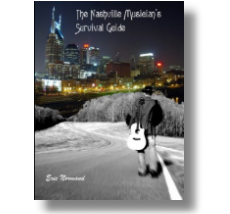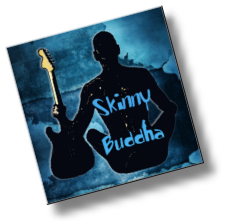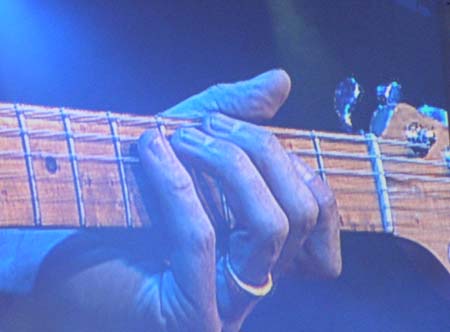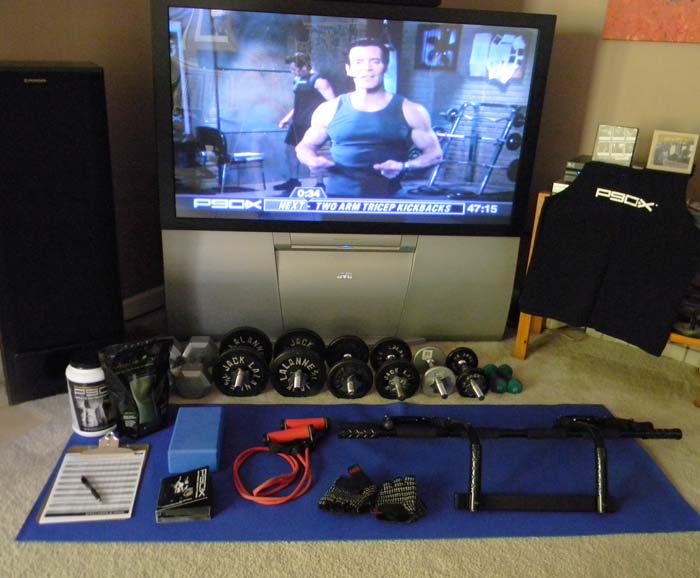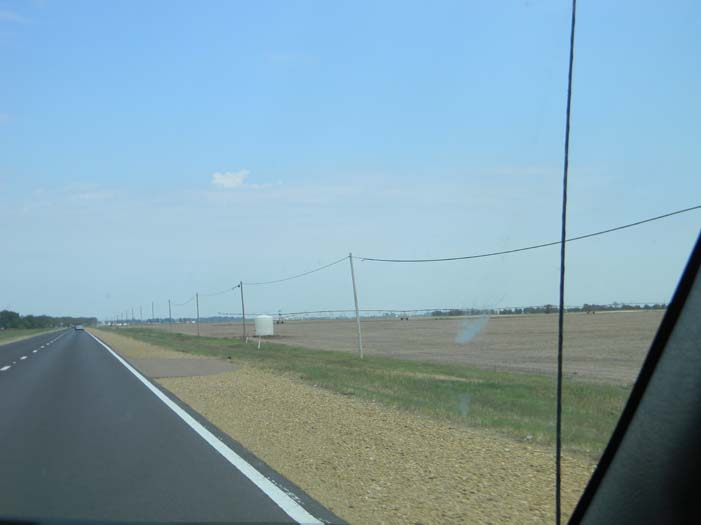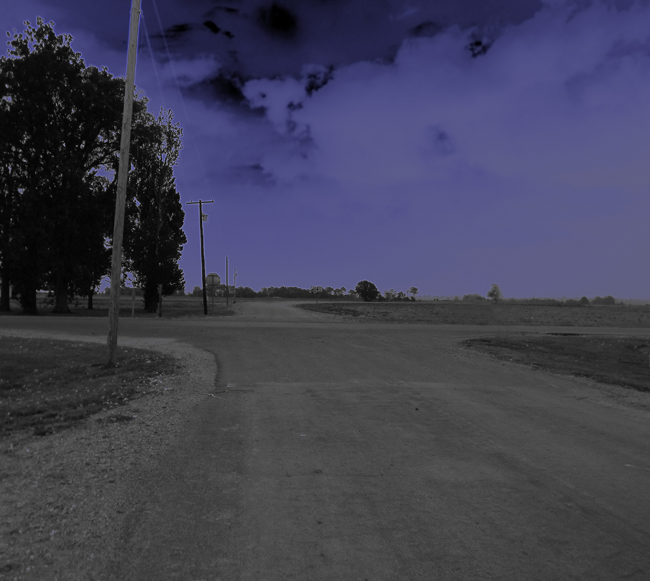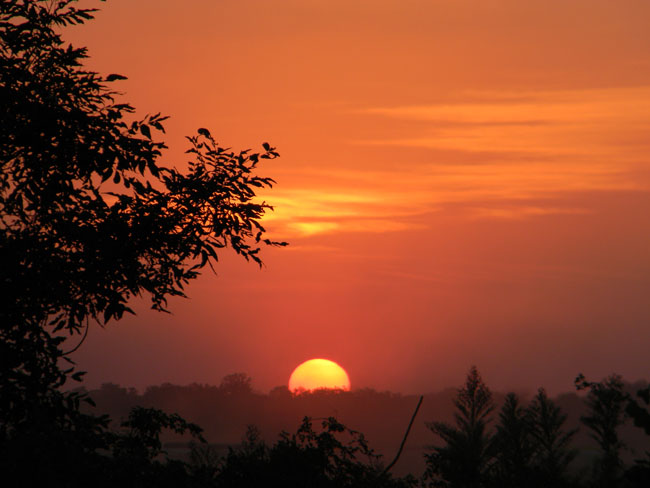
In this day and age, looking the part is often just as important as playing the parts for many professional musicians. This is equally important for those who have not yet achieved a career in music, but are working towards one. While being proficient on your instrument and possessing good social and networking skills are obviously important, in the world of live music performance, your appearance can sometimes be a deciding factor on getting the gig.
It’s easy to find the right clothes, and it’s a well-known fact that working out and having a good physique will make those close “hang well” on your frame. But for some (men especially), the hairstyle, or lack thereof, can be a dealbreaker. I’m not talking about the 20 something’s with the $300 spiky mod looking haircuts. As much as I don’t care for that look, they are not the biggest offenders of the modern day hair wars. In my opinion, it’s the guys who are losing their hair but living in denial that really need to rethink the current state of the top of their heads.
It’s no secret that many of us have lost, are losing, or will lose much our hair over the course of our lives. For some it begins as early as late teens or early 20s, for others it might not happen until they’re in their 30s or 40s, while others manage to hold on to most of their mop 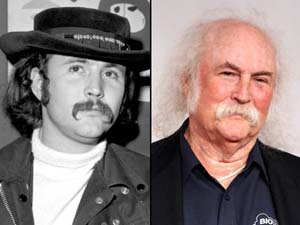 until old age. Sometimes this hair loss happens rapidly, over several months or a couple of years and sometimes it can occur very slowly and gradually over decades. Some just get a little bald patch near the back of our head, while others are stricken with more of that dreaded “parting of the seas” look.
until old age. Sometimes this hair loss happens rapidly, over several months or a couple of years and sometimes it can occur very slowly and gradually over decades. Some just get a little bald patch near the back of our head, while others are stricken with more of that dreaded “parting of the seas” look.
Many musicians take great pride in their hair, often choosing a style that works for them in their younger years and sticking with that as they age. Some will sport short to medium length do’s while others choose to wear it long, anywhere from the mid-60s Beatles look all the way to full-blown hippie length. But if you are in the unlucky category that many of us fall into, that being the permanent hair loss club, these styles will begin to create a different effect and take on new meanings as these 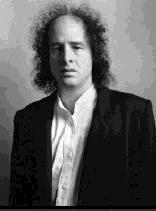 hair follicles slowly begin to vanish forever.
hair follicles slowly begin to vanish forever.
Are you the guy with the comb-over? If you are, you’re not fooling anyone. Maybe you’re the guy that had hair like Greg Allman when you were in your 20s. Oh, how the girls loved it back then. But how are you being perceived now when that part between you’re neatly combed and blowdried shoulder length blond hair rival’s the San Andrea’s fault? Probably more like the friendly lion in the wonderful Wizard of Oz. There’s always a baseball cap. But eventually, as people notice over time that you’re never seen without one, it will become a dead giveaway that you’re hiding something. You could always grow a beard and start wearing a cowboy hat, sporting your version of some kind of half assed Travis Tritt look, but that’s a pretty big commitment, and not that hip anyway. Not to mention, when you commit to the whole hat thing, what happens when you go swimming? What happens the first time you sleep with a new girlfriend?
Face it, none of this works. Yet, somehow, we see people that look like this all the time. Well I have some 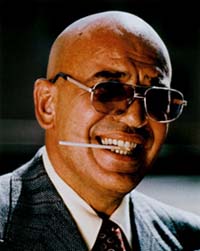 great news for all of you who are fighting this futile “battle of the bald”. There is a way out, and I’m not talking about hair transplants, wigs, or toupe’s. Just let it go. That’s right, shave it off. Bald is beautiful, baby. For proof, look no further than Telly Savalas or Bruce Willis.
great news for all of you who are fighting this futile “battle of the bald”. There is a way out, and I’m not talking about hair transplants, wigs, or toupe’s. Just let it go. That’s right, shave it off. Bald is beautiful, baby. For proof, look no further than Telly Savalas or Bruce Willis.
Growing up, I had a thick head of hair, and by the time I was 15 had already experimented with growing it long. I went in and out of short hair and long hair mode for a few years before going all out in the late 80s, when I began sporting a full-blown Richard Marx style mullet. Of course, at that moment in time that style was in, so spending 20 minutes with a can of moose and a blow dryer to get ready to go out for the night, or gig, was completely natural. Of course I kept this “helmet do” well into the 90s, long after it had become unfashionable. Then, in my mid-20s, it all started going quite badly.
Over a period of about a year, I lost most of the hair in the middle of my head. It happened so quickly that I hardly even noticed at first. But then when my girlfriend started telling me that I was beginning to look like Michael Bolton, I knew something was wrong. On a bad day, my massive bouffant do, once reminiscent of Peter Frampton’s early look, began to look more like that of the comedian, Gallagher. Comments like “Here comes Billy Crystal” or “Is that Stephen Wright?” and even “When did David Crosby lose all that weight?” also caused much embarrassment. So I began a slow transformation. I attempted to minimize my baldness by wearing hats, doo-rags, even at times pulling it back into a ponytail. But ultimately, this wasn’t working. Half the time it just looked bad.
So finally, around the year 2000, I took it down to a fairly short length, just an inch or so on top. It was better than having “Gallagher syndrome”, but still not quite right. Shaving it down to the scalp was the only thing left to try. At first, I was horrified at the thought of doing this, but with a little prodding from my wife, I went for it. Boy am I glad I did. I instantly realized that bald works for me. Having a bunch of hair on the sides with the bald spot in the middle was simply drawing attention to the fact that I was balding. Lose all that hair, and you create the perception that you are bald by choice, not because of nature. In other words, nobody can tell that all your  hair fell out. Now when I look in the mirror, I feel younger.
hair fell out. Now when I look in the mirror, I feel younger.
 Plus there are many added benefits. Showers now take five minutes. I save a small fortune on shampoo and conditioner and haven’t bought a comb or a hair brush in decades. Getting ready to go to work or out on the town now only takes seconds. It’s harder to get dandruff, and my head is now essentially “lice-proof”. But most important of all, I no longer look like an idiot.
Plus there are many added benefits. Showers now take five minutes. I save a small fortune on shampoo and conditioner and haven’t bought a comb or a hair brush in decades. Getting ready to go to work or out on the town now only takes seconds. It’s harder to get dandruff, and my head is now essentially “lice-proof”. But most important of all, I no longer look like an idiot.
So which guy are you? Are you still clinging to the past, or have you embraced your inner baldness? Whose look do you relate to more, Stephen Gallagher or Bruce Willis? It’s not too late to save yourself. So what are you waiting for, get out those clippers and get busy!
Saturday night was the first outing for my new band ‘Endless Boogie’, and fun was had by all who ventured out to party with us at the Fillin’ 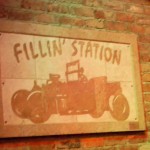 Station in Kingston Springs, TN. The club, owned by Patrick Weickenand, was the perfect setting for my long awaited rock n’ blues experiment. Small, intimate, and loaded with character, the club is housed in an old garage right out of yesteryear, hence the name, and a favorite watering hole for the locals on the west side of town.
Station in Kingston Springs, TN. The club, owned by Patrick Weickenand, was the perfect setting for my long awaited rock n’ blues experiment. Small, intimate, and loaded with character, the club is housed in an old garage right out of yesteryear, hence the name, and a favorite watering hole for the locals on the west side of town.
Our trio started out with a couple of instrumentals to get things going before switching to some vocal-based tunes. The place wasn’t too busy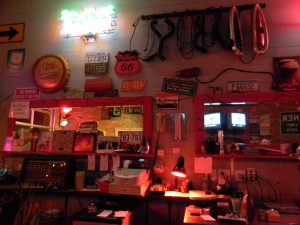 during our first set, so Patrick, who was working the bar, had time to sit in on harp for a few tunes in between slinging beers. Patrick is one of the nicest guys you’ll ever meet, and undoubtedly contributes greatly to the warmth and charm of this unique place. Anyone who has ever played the Fillin’ Station knows that Patrick is a great harp player, and he’s frequently requested to ‘sit-in’ from behind the bar with many a band. So several times throughout this night he joined in for some fun jams (check out the video below).
during our first set, so Patrick, who was working the bar, had time to sit in on harp for a few tunes in between slinging beers. Patrick is one of the nicest guys you’ll ever meet, and undoubtedly contributes greatly to the warmth and charm of this unique place. Anyone who has ever played the Fillin’ Station knows that Patrick is a great harp player, and he’s frequently requested to ‘sit-in’ from behind the bar with many a band. So several times throughout this night he joined in for some fun jams (check out the video below).
Fran Breen (drums) and Mike Chapman (bass), aside from being good friends of mine, are seasoned pros and I was thrilled to have them on the gig. Talk about groove, boy these guys can lay it down! I had an absolute blast playing with them, and we plan to do this on a regular basis, schedules permitting. As of right now our next outing will be Friday, December 3rd back at the Fillin’ Station.
By the third set, the place had erupted into a full-blown dance party which held through to the end. People were even dancing on Whipping Post (if you’ve ever tried to dance to this song you know why this is significant). All in all it was a triumphant beginning to this new project, a project born out of my need for “a little music for the soul”.
As a professional freelance musician working and living in Nashville, much of the work I perform is for other people’s entities, as is true for many hired guns. I’m not complaining mind you, this is how the bills get paid. My regular gig as tour manager/guitarist for Rhett Akins occupies many weekends throughout the year, and sporadic nightclub gigs and songwriter recording projects help to fill in the gaps. As rewarding as some of this work can be, it all comes under the heading of ‘gun for hire’ which means I must meet somebody else’s expectations, as they are footing the bill, often adjusting my musical tastes and desires to fit the gig.
So whenever it’s feasible, I take on gigs purely for my own musical expression, a little ‘music for the soul’ as I call it. Now that fall is here and the annual touring/festival season is drawing to a close, I’ll have a little more time for these kinds of endeavors. With that, I’m excited to tell you about my new project – Eric Normand and Endless Boogie. The concept of this band is simple. I will play only music that I enjoy playing, with people whom I enjoy playing, in venues that are enjoyable to play.
Growing up in the 70s and 80s I always looked back a few years to find my musical heroes; Jimi Hendrix, the Allman Brothers, ZZ Top, John Lee Hooker, and to this day this is still some of the most expressive music I ever play. So in my new Nashville based ‘fun band’ that’s just what were going to do. The song list will contain Hendrix classics like Little Wing, Voodoo Child, and All along the Watchtower, Allman Brothers classics like You Don’t Love Me, Ain’t Wastin’ Time No More, Melissa, and Whipping Post, classic blues songs like Freddie King’s Going Down, John Lee Hooker’s Hug You, Kiss You, Squeeze You, and even a few of my favorite instrumentals by Miles Davis and The Meters. Needless to say, we will put our own spin on these.
As I live in Nashville, and this kind of song list will not command top pay, getting great players to commit to a gig like this isn’t easy. All the best players are usually pretty busy taking the most lucrative gigs offered, and even if you get them to commit, something always seems to come up. So you either have to have two or three players deep on each instrument that know your material, or you have to wait till the last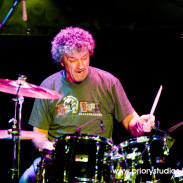 minute to book the players. I got real lucky for this first outing of Endless Boogie as a couple of my good friends, Fran Breen and Mike Chapman, just happened to be available.
minute to book the players. I got real lucky for this first outing of Endless Boogie as a couple of my good friends, Fran Breen and Mike Chapman, just happened to be available.
Fran Breen is a world-class drummer from Ireland that has worked on and off in the Nashville music industry for over 20 years. He’s played with a few major artists like Lucinda Williams, Nancy Griffith, Shelby Lynn, and is also an accomplished session drummer having played on countless projects over the years including the soundtrack for the movie “The Commitments” . He’s a top notch groove machine, especially when it comes to blues and funk, and I’m thrilled to have him on the gig. (Plus he is really funny and has the coolest Irish accent.)
Mike Chapman is one of the best bassists Nashville has to offer, and another ace in the hole who happens to be a good friend of mine. Mike’s first big gig was with Hank Williams Jr. in the early 80s, since which time he has played on innumerable A-list recording sessions ranging from literally all of Garth Brooks recordings to Leanne Rimes, Brooks & Dunn, Huey Lewis and countless 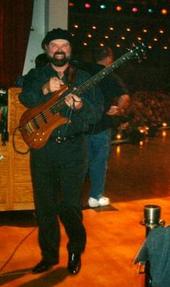 others. Mike has played bass on over 30 number 1 singles and the albums that he has played on have sold over 150 million copies. If it sounds like I’m bragging a little bit about these guys, it’s because I am. I mean how often does one get to say “My drummer played on the Commitments soundtrack” or “My bass player has been heard on 150 million albums”?
others. Mike has played bass on over 30 number 1 singles and the albums that he has played on have sold over 150 million copies. If it sounds like I’m bragging a little bit about these guys, it’s because I am. I mean how often does one get to say “My drummer played on the Commitments soundtrack” or “My bass player has been heard on 150 million albums”?
The last ingredient for my first outing with ‘Endless Boogie’ is a fun venue in which to play. The Fillin’ Station, located on Main Street in Kingston Springs, is the perfect venue for an intimate night of exploratory rockin’ blues and funk jams. While playing on big tours in front of thousands of people can be exciting, sometimes the finer points of the music get lost in the ‘bigness’ of those events. To this day, my favorite musical settings are small to midsize nightclubs, for it is in these small-town bars and juke joints of the world where the magic really happens. The Fillin’ Station is owned by Patrick Weickenand, former member of Eric Burdon’s band ‘War’ and one of the nicest guys you’ll ever meet who also blows a mean harp from behind the bar from time to time. The club is small but comfortable, and has an adjoining outdoor patio which fills up with locals on many a night. The club is just 25 minutes from downtown Nashville (exit 188 off of I40 west) and features live music four to five nights a week year-round, never with a cover.
I’ve been wanting to put together a group like this for a few years now, toying with the idea periodically, but never quite getting organized enough to make it happen. But I’ve realized that this is just what you have to do in Nashville, you have to find a way to not lose sight of your own vision even while you spend most of your time working for other people. My musical dreams at this point of my life are quite simple, I want to play the music that I love to play, the way I want to play it, hopefully taking a few others along for the ride.
So that’s it, all the essential ingredients are in line for an expressive night of music – songs I enjoy playing, people I enjoy playing with, and a place I enjoy playing at. Our show will be this coming Saturday, October 16 from 7:00 to 11:00. I’m really pumped for this show, so if you live in the Nashville area come on down for a night of Endless Boogie!
Becoming a successful musician or an entertainer in the 21st century is a tough endeavor. It’s probably as difficult as becoming a successful actor in Hollywood. In this field of extreme competitors, you need to have every advantage you possibly can. Even if you aren’t going after the big prize, for many musicians, a lifetime of pursuing their craft will still take its toll. This is why it is in the best interest of most musicians to be physically fit.
If you are a musician, whether you play guitar, drums, sing, saxophone, or other, you inevitably fall into one of two categories; 1.) Professional musicians, semi professional musicians, and musicians aspiring to become professionals, or 2.) Amateur musicians, hobbyists, and musicians that play solely for expression, art, or the fun of it, regardless of compensation.
If you are either working as a professional musician, or aspiring to do so, you probably already know how competitive this field is (if you don’t, you might want to take a look around you). To earn a living as a musician in this day and age, or at least a partial living, a great many things must come into alignment. Talent, social skills, looks, longevity, and luck are some of the essential components. Since you really can’t control luck, and assuming you have some talent and social skills and are already honing those traits, that leaves looks and longevity up for grabs. This is where physical fitness comes into play.
Looking Good
I chose to address this factor first because so much of what happens in the entertainment industry is based on appearances. As superficial as this may be, it is simply a fact, and one that shouldn’t be overlooked. While I do feel that looks and talent shouldn’t have to be tied together, the focus here is on the music business, so I’ll save that discussion for another time.
We have a strange way of approaching how we look in our society, that being that we tend to put makeup on a pig. I’m sure you’ve heard that expression before, but here’s my spin on it. How many times have you seen some performer, whether on TV or in a nightclub, who has obviously put a lot of thought into his or her wardrobe and appearance? $300 haircuts, pre-ripped and pre-faded designer jeans, fancy shirts, eye-catching jewelry, makeup, even an obvious obsession with tanning is evident for some. Yet when you look at the performer’s arms , there isn’t a hint of muscle tone to be found anywhere. Even though they aren’t obviously overweight, you can’t help but notice their ass looks just a little too big for the outfit struggling to hide it. Or perhaps he or she has no ass all, flat as a board on the backside due to the fact that they have no muscles there either. Of course this description would describe many people in almost any field. As most Americans are now overweight, each year the numbers steadily increasing, so is our desire to attempt to mask this fact with fancy haircuts, designer clothes, spray-on tans, and makeup.
But if you are aspiring to be a professional musician, you are different than most people, you are in the world of showbiz. This means that, in many cases, your appearance is directly tied to your career, and sooner or later you will be judged on your looks. So rather than continuing to follow the trend of ‘putting makeup on a pig’ why not address the issue at its core and put more emphasis on physical fitness. There is a difference between being skinny, a little overweight, and being physically fit. I have been skinny for most of my life, but I have not always been fit. When you are physically fit clothes automatically hang better, your skin color looks better, and your face looks younger. People who are physically fit tend to have increased energy and stamina, and this helps to project a more youthful vibe in general. Not to mention the increased confidence and sex appeal that can come with being in great shape. With the music and entertainment industries now more competitive than ever, there is simply no excuse to not look as good as you possibly can. A fancy haircut and designer clothes aren’t going to fool everybody.
Longevity
To me, the need for longevity makes the best case for being physically fit, and this applies to all musicians, pro or otherwise. From the time we were teenagers, through our 20s, even into our 30s, typically, our bodies are still functioning under their original drivetrain warranty, meaning that, at least for most of us, things aren’t yet starting to go wrong on the grand scale that they eventually will. If you are a young person and reading this, you’re probably thinking “That’s the kind of crap my grandfather used to tell me.” Well I hate to say it, but ol’ grandpa was right. As our bodies age our joints begin to wear, we become more susceptible to injuries, injuries take longer to heal, and a whole host of other problems ranging from high blood pressure to heart disease and beyond start becoming more likely. I’ve had tendinitis for five years now, and sometimes it interferes with my playing. Some of my musician friends, after decades of problem free careers, are now starting to have their own problems too. Everything from back problems to carpal tunnel and even diabetes and strokes are now interfering with their careers and lives.
The effects of aging can and will happen to people from all walks of life, but the hard lifestyles of many musicians can further amplify the effects of aging. Being a musician is stressful, often requires extensive travel, and for many of us, requires a repetitive hand, arm, or leg motion that is certain to lead to problems. Being physically fit is the only way to combat these problems. Alcohol or drugs, whether prescribed or other, are only a band-aid, and for many, masking the pain in this way can lead to further injury. Being a career musician, I often have little to no choice about the gigs I need to take to make a living. Sometimes I will play a 3 1/2 hour show nonstop. This requires great stamina and, even though I am in good shape, sometimes my whole body aches after a long hard gig. How much worse would I hurt if I didn’t take care of myself? I still have to load my gear into my car regularly and my Vox amp weighs almost 100 pounds. Over the years, I’ve thrown out my back doing this on more than one occasion, being physically fit helps combat this as well. Regular exercise has been the best weapon against my tendinitis too. Without regular stretching and exercise it quickly becomes almost unbearable.
In the world in which we live and work, a world full of extreme competition, an extreme approach to health and fitness simply makes sense. Some people say that America has the best workforce in the world. If this is true, shouldn’t the best workers be in tip top shape? You can either continue ‘putting makeup on the pig’, or you can work towards becoming fit and give yourself a real leg up on the competition. Even if you don’t aspire to play professionally being fit will help ensure the likelihood of enjoying your hobby or art for years to come. As far as achieving an extreme level of physical fitness, there is no shortcut. It can only be achieved with good old-fashioned hard work which involves a lifelong commitment to regular exercise and healthy eating.
Do you want to look good when you’re 50? Do you want to still be able to play music effortlessly when you’re 60? I do.
While we awoke Sunday morning in high spirits, we were sad to see this trip drawing to a close. What was originally planned as a simple three-day getaway wound up being a prolific, life-changing experience. We thanked Marc for her hospitality and informed her that the Shack up Inn had just become at least an annual destination for us. As we made our exodus, heading north on Highway 61, we again took in to view a seemingly endless sea of cotton. We basked in the memories of the trip for most of the five hour drive home, recounting several high points still fresh in our minds.
While our explorations may not have revealed every facet of this community, this it did reveal; Clarksdale, while being one of the poorest places we have ever visited (economically speaking), is rich in its heritage, rich in spirit, its wealth defined by the warm and open nature of many of its citizens, and by this community’s enduring and ongoing contributions to the vital music our world so badly needs. In the circles we traveled during our stay, all of the locals we encountered were friendly and courteous, seeming to understand and appreciate the musical history that was born unto this place and the interest it still procures. It is an atrocity that most Americans are unaware of the cultural and musical heartbeat that dwells here.
Through a continuing appreciation for the music and culture of the Delta by some unlikely world citizens, citizens from every race, sex, and ethnic background, Clarksdale is a true melting pot, even if the pot is somewhat temporary. People from all walks of life and from every corner of the U.S., Europe, Asia, and beyond gathering in these sacred music halls for some song and dance – this isn’t history, this is today, and tomorrow, and I believe that many who visit Clarksdale will forever carry a piece of this culture and music with them, perhaps even a renewed sense of hope and purpose from their experiences here. I know we will. We came for a vacation, and while it was all of that, the experience was transformational, a musical and cultural revelation we are thankful to have had.
If you are a fan of blues or blues-influenced music, the Clarksdale experience is a must, there is a deep rooted blues subculture alive and well here. If you are a history buff, you can learn more about the American struggle by visiting this place for just one day then you can from most history books. If you just want to have a great vacation, you can do that too.
Feeling compelled to document this journey as thoroughly as possible, Kelly and I took around 500 photos over this three-day adventure. While ‘vacation pictures’ are never as interesting to anyone else as they are to the vacationers, we have decided to post most of them in a photo Journal for all to see. I have broken them down into several albums, each listing the day and the subject matter. If you are considering a trip to Clarksdale, or just curious about the place, this photo album should provide some perspective. Eric and Kelly’s Clarksdale Photo Journal
Friday Morning at the Shack Up Inn
Friday morning came a little too early when we were awoken by some sort of tweety bird chirping right outside our bedroom window 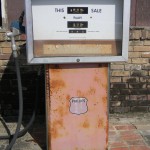 around 7 AM. With the help of some earplugs, we were able to fall back asleep for a couple more hours with hardly a sound from the outside world audible from inside our little shack. After eating some breakfast while listening to a little Robert Johnson, I decided to go on a photo taking expedition around the grounds. It might not be right for everyone, but I found the decor around the Shack Up Inn immensely interesting. Rusted old farm equipment decorated the lawn, old Coca-Cola signs were placed at random, a tree was covered with blue and green bottles – these folks had figured out how to turn what might otherwise be considered junk into art, and this helped make the Inn feel like some sort of living
around 7 AM. With the help of some earplugs, we were able to fall back asleep for a couple more hours with hardly a sound from the outside world audible from inside our little shack. After eating some breakfast while listening to a little Robert Johnson, I decided to go on a photo taking expedition around the grounds. It might not be right for everyone, but I found the decor around the Shack Up Inn immensely interesting. Rusted old farm equipment decorated the lawn, old Coca-Cola signs were placed at random, a tree was covered with blue and green bottles – these folks had figured out how to turn what might otherwise be considered junk into art, and this helped make the Inn feel like some sort of living 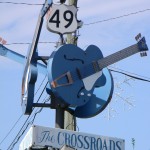 museum of the old American South.
museum of the old American South.
We set out a little while later to begin exploring downtown, and our first stop was to take a few photos of the ‘crossroads’ sign at Highway 49. The picture in my mind of this place where Robert Johnson allegedly made his deal with the devil is of course nothing like this modern touristy version, as this intersection is now surrounded with businesses including the adjacent Churches Chicken. It was still worth a few pictures, and later in the day I accidentally found another intersection in town that looked eerily like the crossroads I envisioned.
Downtown Clarksdale
As we continued driving towards downtown we began to notice how poor this community is, seeing many run down buildings, once occupied by businesses and services, now empty, their exteriors slowly deteriorating. Upon arriving downtown we easily found a free parking spot near the Delta Blues Museum and began our first walk around amidst some light foot traffic. Our first stop would be Blues 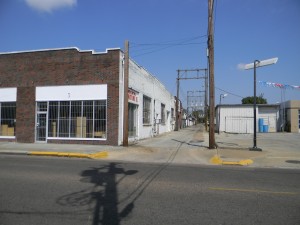 Town Music, a local music store filled with cool old gear, worthy of the store’s namesake. An Asian man was sitting on a stool and playing some traditional blues on an open tuned guitar – “I saw you play at Ground Zero last night. Great playing!” he commented. “Thanks. I’m Eric, pleased to meet you.” “My name is Gypsy, and I’m here on vacation from Japan.” he informed me, and after some conversation I learned this was his 10th trip to Clarksdale. We continued our stroll, taking in the sights of this obviously once booming town, now struggling for its very survival. The downtown area had pockets of activity, and other areas that seemed void of all life. Many of the buildings looked like they hadn’t been painted in decades, some with boards on the windows, others with bars on them. As we continued our walk on some of these near empty streets, this kind of sporadic hot and cold ghost town feeling was almost a bit unnerving, however, not once did we feel in danger.
Town Music, a local music store filled with cool old gear, worthy of the store’s namesake. An Asian man was sitting on a stool and playing some traditional blues on an open tuned guitar – “I saw you play at Ground Zero last night. Great playing!” he commented. “Thanks. I’m Eric, pleased to meet you.” “My name is Gypsy, and I’m here on vacation from Japan.” he informed me, and after some conversation I learned this was his 10th trip to Clarksdale. We continued our stroll, taking in the sights of this obviously once booming town, now struggling for its very survival. The downtown area had pockets of activity, and other areas that seemed void of all life. Many of the buildings looked like they hadn’t been painted in decades, some with boards on the windows, others with bars on them. As we continued our walk on some of these near empty streets, this kind of sporadic hot and cold ghost town feeling was almost a bit unnerving, however, not once did we feel in danger.
We walked over to the Ground Zero Blues Club to snap a couple of quick pictures in the daylight, and continued onward in search of the legendary ‘Red’s Blues Club’, the infamous juke joint everyone seemed to hold in such high regard and our destination for later that night. Coming out the back side of the Ground Zero parking lot we came to a large abandoned blue brick building touting the sign ‘Delta Wholesale Hardware Co.’ before crossing the train tracks. A little further down the road we spotted another old brick building with a couple of smokers sitting on the curb in front. Somehow we just knew this was Red’s and ventured closer to take a peek. If you didn’t know what you were looking for you would never think to stop at this Sanford and Sonesque place, it’s curb littered with a beat up old couch, a broken toilet, and several large pieces of homemade barbecue apparatus. Above a tattered old canopy the faded words 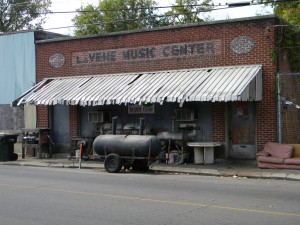 ‘LaVENE MUSIC CENTER’ were stenciled onto the brick, perhaps remnants of another failed business out of yesteryear. Only once right upon the sidewalk did the sign ‘Red’s Blues Club’ become visible. It was a curious moment of realization knowing that a few hours later we would likely be experiencing something very unique and special.
‘LaVENE MUSIC CENTER’ were stenciled onto the brick, perhaps remnants of another failed business out of yesteryear. Only once right upon the sidewalk did the sign ‘Red’s Blues Club’ become visible. It was a curious moment of realization knowing that a few hours later we would likely be experiencing something very unique and special.
We began walking back to our car to return to the shack for some lunch when a friendly local volunteered to take our picture. For a split second we both had the vision of the scene in National Lampoon’s ‘European Vacation’ when a local runs off with the tourists camera, but that didn’t happen, this local was quite genuine.
Cat Head Delta Blues and Folk Art
Upon returning downtown a couple of hours later our first stop would be at 252 Delta Ave, home of Cat Head Delta Blues and Folk Art. The place was kind of a cross between a gift shop and an art gallery for blues aficionados containing CDs, DVDs, books, T-shirts, and some amazing local folk Art. They had a large collection of documentaries and books about blues history and culture available and I could have easily spent a small fortune. Not having grown up in the South, I asked the man behind the counter about the origins of the term ‘Cat Head’. He explained to me that “In the early 1900’s ‘Cat Head’ was a company that made giant biscuits, biscuits so large they were the size of a cat head.” In addition to being a store selling everything related to the blues, Cat Heads website is kind of a central gathering point for information pertaining to not just Clarksdale’s live music scene and points of interest, but to blues related events throughout the Delta. After browsing the store for a little while longer while listening to some obscure blues recordings over the speakers, we went on down the road.
Located on East Second Street, (a little bit off the beaten path) we found our way into the museum and were greeted by ‘Theo’. Theo is originally from Europe and the owner of the museum and, above all else, Theo loves American blues music, history, and culture. After paying the minimal entry fee of five dollars a head, well worth every penny mind you (not to mention helping this great nonprofit organization), we began exploring this massive collection of American roots music culture. “Roots to Fruits”, Theo explained, is the theme of this museum, and if you walk through the museum on the recommended path, it shows the evolution of the earliest blues artists and recordings, and how that music transcended across generations and continents giving birth to early blues influenced rock and roll artists like Elvis, the Beatles, and the Stones before morphing into the roots of modern rock with artists like Jimi Hendrix, Led Zeppelin, the Who, and beyond. Amidst this collection of rarities, which I learned was moved here from Europe about five years ago, were some of the earliest and rarest blues records, concert posters, early record players and jukeboxes, even an old barber chair that came from a local barber shop in which John Lee Hooker and many other legends got haircuts back in the day. We saw the Muddy Waters record which gave birth to the Rolling Stones namesake, its title bearing ‘Rolling Stone’. The original contract offer form for the Who’s performance at Woodstock, where they received $6250.00 for their historic performance. Pencil drawings by John Lennon, the controversial Jimi Hendrix ‘Electric Lady Land’ album sleeve bearing several nude ladies, and Muddy Water’s ‘contract rider’. We could’ve stayed in there all day, and this would have been especially easy to do as Theo loves to talk, but we said goodbye as we still needed to check out the Delta Blues Museum.
This nonprofit museum is also a must see for anyone who wants to learn more about American blues culture. We arrived a bit late in the day, only about 45 minutes before closing, so we had to breeze through a little faster than we might have preferred. However, the 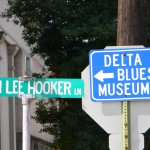 place is magnificent. Early blues recordings can be heard playing over the loudspeakers upon entering the lobby. After we paid our entrance fee of seven dollars each, we walked into a giant room that seemed to radiate from another era. The walls were covered with records, plaques, and drawings of blues legends that came from this part of the Delta. Guitars, clothing, and other memorabilia from artists like Charlie Patten, Son House, Ike Turner, and countless others who had grown up within a few miles of this place were beautifully displayed within plexiglass cases. Perhaps the deepest moment of experience we had within this giant roomful of blues was the Muddy Waters exhibit. The original sharecropper shack in which Muddy Waters grew up had been placed inside this room, complete with one of his old Fender Twin amplifiers, and a legendary guitar commissioned for the museum by Billy Gibbons that had been built from one of the pieces of wood from this shack. Inside the shack, videos showed archival footage of Muddy as well as interviews with his peers, all to a soundtrack of his rootsy music. The moment was revealing knowing the hard life this man must have endured, growing up with his family in such a small coarse space in pre-civil-rights America. It was difficult to pull ourselves away, and we gradually made our exodus as the museum was about to close.
place is magnificent. Early blues recordings can be heard playing over the loudspeakers upon entering the lobby. After we paid our entrance fee of seven dollars each, we walked into a giant room that seemed to radiate from another era. The walls were covered with records, plaques, and drawings of blues legends that came from this part of the Delta. Guitars, clothing, and other memorabilia from artists like Charlie Patten, Son House, Ike Turner, and countless others who had grown up within a few miles of this place were beautifully displayed within plexiglass cases. Perhaps the deepest moment of experience we had within this giant roomful of blues was the Muddy Waters exhibit. The original sharecropper shack in which Muddy Waters grew up had been placed inside this room, complete with one of his old Fender Twin amplifiers, and a legendary guitar commissioned for the museum by Billy Gibbons that had been built from one of the pieces of wood from this shack. Inside the shack, videos showed archival footage of Muddy as well as interviews with his peers, all to a soundtrack of his rootsy music. The moment was revealing knowing the hard life this man must have endured, growing up with his family in such a small coarse space in pre-civil-rights America. It was difficult to pull ourselves away, and we gradually made our exodus as the museum was about to close.
The Crossroads
Having thoroughly explored the streets and sites of this unique downtown during the daylight hours, we returned to our shack for dinner and a shower, anxious for our second nighttime adventure into this land of the blues. I had noticed earlier in the day that the intersection of the road leading into the Shack Up Inn, especially from one particular angle, looked a bit like the crossroads of the Robert Johnson era that I had many times pictured in my mind. So right before dinner, with the sun low in the western sky, I snapped a few photos to see if I could capture the unique feeling of standing at such a foreboding spot out of American folklore. A little while later I couldn’t help but to experiment with my picture in Photoshop, and with a few quick adjustments, I had a photo that, at least to me, looked like ‘the crossroads’ where Robert might have made his deal.
Red’s Blues Club
We arrived at Red’s just after 9:00 PM and ‘Big Anthony’ was getting ready to play. The place was still near empty and, after paying a five dollar cover charge, we found a seat and began to take in the sultry scene. Red was working behind the bar and sporting a pair of dark sunglasses in an already dimly lit room. I’m not sure if it’s intentional or not, but the lighting in Red’s is just that – red. Red colored 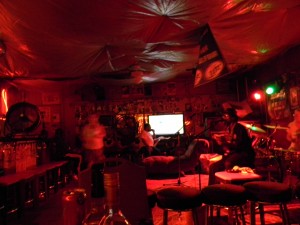 neon signs scattered throughout and a couple of red colored lights aimed at the stage create a kind of reddish hue that was inescapable. The place was fairly small, about 20 x 40, and sheets of plastic haphazardly covered the ceiling. Every square inch of the walls was covered with something, be it photos, posters, beer signs, or the lone flat screen TV which never went off. The place had 2 air conditioners which occupied the only windows in the place and a series of fans placed strategically (or randomly) at different locations throughout. The furnishings were comprised of several varieties of barstools, tables, chairs, and couches, all mis-matched and old looking, yet amazingly comfortable. The performance area faced the bar, and its central location seemed to optimize the room. On either side of the ‘stage’ stood a giant column of four or five speakers, circa 1980’s, although it only seemed like a couple of them were being used.
neon signs scattered throughout and a couple of red colored lights aimed at the stage create a kind of reddish hue that was inescapable. The place was fairly small, about 20 x 40, and sheets of plastic haphazardly covered the ceiling. Every square inch of the walls was covered with something, be it photos, posters, beer signs, or the lone flat screen TV which never went off. The place had 2 air conditioners which occupied the only windows in the place and a series of fans placed strategically (or randomly) at different locations throughout. The furnishings were comprised of several varieties of barstools, tables, chairs, and couches, all mis-matched and old looking, yet amazingly comfortable. The performance area faced the bar, and its central location seemed to optimize the room. On either side of the ‘stage’ stood a giant column of four or five speakers, circa 1980’s, although it only seemed like a couple of them were being used.
Anthony spotted me from across the room and made his way over asking “Did you bring a guitar?” “Yeah, but I came to hear you play. I’ll get it in a little while.” A few minutes later a friendly older gentleman, who seemed to know everybody, walked on over to our table and said “I’m going to sit with you folks tonight, if that’s okay.” “Of course, have a seat.” I said, later learning his name to be Dingo. We ordered a couple of beers and set our bottle of tequila on the table next to Dhingo’s bottle of Evan Williams whiskey. Beer is the only alcohol sold at Reds, therefore allowing a BYOB for liquor only.
Anthony’s show began as perhaps the most subtle start to a performance I have ever seen. Also wearing sunglasses, “A” was sitting on a stool with a cigarette hanging out of his mouth when he began playing some blues guitar licks, backed only by a drummer. There were maybe only six or eight of us in the room at this point, and the feeling was relaxed and comfortable as Anthony played his brand of  Delta blues. He must have played seven or eight blues instrumentals, for nearly an hour, before the vocal portion of his night would begin. The music was earthy and hypnotic and it felt as if time had stood still. As his deep voice resonated some mournful passages, I felt transported to another era. Gradually the night picked up and people started coming in. Another local sat in on backup vocals for a couple of songs, and then Dingo was up to sing a little too. The dance floor (or carpeted area in front of the band) had a few eruptions of activity throughout the night whenever locals and tourists felt the mood. At one point Anthony asked different folks around the room where they were from. The answers were as diverse as imaginable – Italy, Canada, Switzerland, New Orleans, Japan, San Francisco, Tennessee, Australia – people from all over somehow knew about this hidden blues universe.
Delta blues. He must have played seven or eight blues instrumentals, for nearly an hour, before the vocal portion of his night would begin. The music was earthy and hypnotic and it felt as if time had stood still. As his deep voice resonated some mournful passages, I felt transported to another era. Gradually the night picked up and people started coming in. Another local sat in on backup vocals for a couple of songs, and then Dingo was up to sing a little too. The dance floor (or carpeted area in front of the band) had a few eruptions of activity throughout the night whenever locals and tourists felt the mood. At one point Anthony asked different folks around the room where they were from. The answers were as diverse as imaginable – Italy, Canada, Switzerland, New Orleans, Japan, San Francisco, Tennessee, Australia – people from all over somehow knew about this hidden blues universe.
Now pretty far into this evening and feeling fine, I asked Anthony between songs if I could play a couple with him. He nodded yes, so I went out and grabbed my guitar and amp. I joined him and his band of drummer ‘the Clarksdale All-Stars’ for two or three up-tempo blues, a high point coming on the last song with a little ‘head cutting’. Already having played two and a half hours straight, Anthony suggested I sing a couple while he took a break. His drummer stayed on and I played a couple of blues classics before launching into a funky version of Hendrix’s ‘Voodoo Child’ which received a roaring applause. I returned to the stage to Anthony, and a little while later when we were getting ready to leave, Red made his introduction. “You should come back tomorrow night, ‘T-Model Ford’ will be here and it’s gonna’ be a good time. Bring your guitar too. The old guys don’t mind other musicians playing with them.” “Were supposed to go to Memphis tomorrow, but if we can rent our room for one more night we just might do that. Are you sure it would be okay for me to play with him?” I asked. “This is my place, just come on down and bring your guitar.” I then grabbed the unopened bottle of Evan Williams, Red’s whiskey of choice, from the back of my amp and presented it to Red. “We read on the Internet that this is your favorite whiskey, so we brought you a bottle as our way of saying thanks.”
With that, we headed back to the shack. Having had such an amazing experience so far, the idea of leaving for Memphis in the morning was growing less likely by the minute. 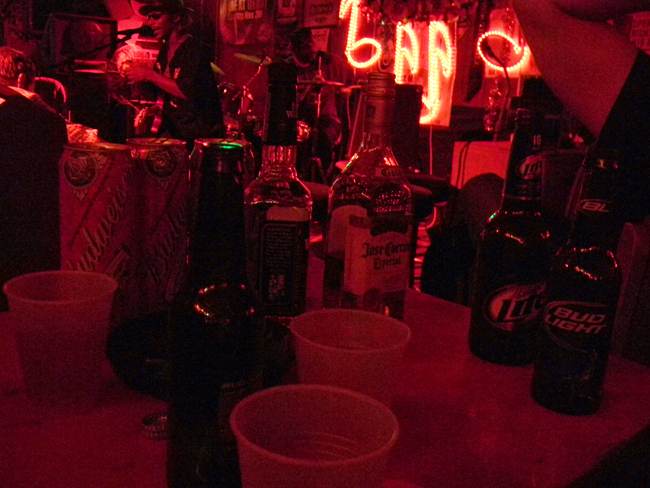
The Drive
It was noon on Thursday, September 23 when we left our Pegram, TN home bound for Clarksdale, Mississippi. Our route took us west on Interstate 40 for about 200 miles to Memphis, and while this stretch of I-40 is typically a rather boring drive, on this hot summer day, whatever was lacking in visual stimulation was replaced with anticipation. Although we had done a fair amount of research, we still didn’t know exactly what to expect in Clarksdale, so our excited conversations ultimately kept us from noticing that the scenery out the car window hadn’t changed much for the first three hours of the trip.
At Memphis we turned south onto Interstate 55 and entered Mississippi, and while the first hour of I-55 wasn’t anything visually 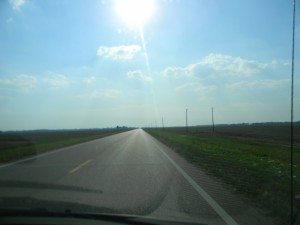 extraordinary, as soon as we turned west on to Highway 278 it felt like we entered a new world. The dense forest that had occupied both sides of the road only minutes before vanished to reveal a wide open view of the Delta plane. Cotton fields stretching to the horizon, cut in two by the road on which we traveled, a seemi
extraordinary, as soon as we turned west on to Highway 278 it felt like we entered a new world. The dense forest that had occupied both sides of the road only minutes before vanished to reveal a wide open view of the Delta plane. Cotton fields stretching to the horizon, cut in two by the road on which we traveled, a seemi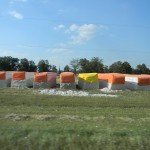 ngly endless road, straight, flat, and disappearing as far into the distance as the eye could see. Aside from other vehicles on the highway, the occasional farmhouse, and farm equipment sparsely scattered throughout the fields, the vastness of this geography was otherworldly. Although this last 40 or so miles was the shortest leg of the drive, our virgin viewing of this fertile Delta plane was empowering and made us feel a bit the wiser, almost as if we were the first explorers to set foot upon a newly discovered continent.
ngly endless road, straight, flat, and disappearing as far into the distance as the eye could see. Aside from other vehicles on the highway, the occasional farmhouse, and farm equipment sparsely scattered throughout the fields, the vastness of this geography was otherworldly. Although this last 40 or so miles was the shortest leg of the drive, our virgin viewing of this fertile Delta plane was empowering and made us feel a bit the wiser, almost as if we were the first explorers to set foot upon a newly discovered continent.
The Shack Up Inn and The Robert Clay Shack
Upon entering Clarksdale, located in Coahoma County, Mississippi, we turned south onto Highway 49 for a couple of miles and found 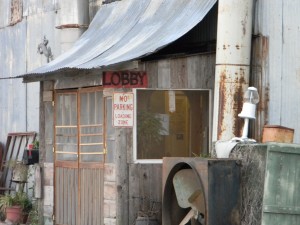 our way to the Hopson Plantation and the location of the place we would be staying, The Shack Up Inn. As we crossed over some railroad tracks, several old ‘barn-like’ buildings covered with rusty corrugated tin came into view, and we passed a row of shacks as we began searching for the lobby. At first glance the main entrance appeared to be a cross between an antique store and a junkyard, and if
our way to the Hopson Plantation and the location of the place we would be staying, The Shack Up Inn. As we crossed over some railroad tracks, several old ‘barn-like’ buildings covered with rusty corrugated tin came into view, and we passed a row of shacks as we began searching for the lobby. At first glance the main entrance appeared to be a cross between an antique store and a junkyard, and if 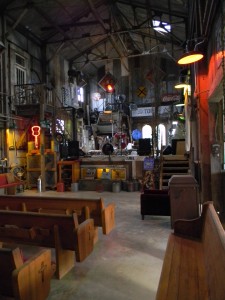 it were not for a small red sign bearing the hand-painted word ‘lobby’, we might have driven right by. We were greeted warmly by Marc, the woman working at the front desk, and she checked us in while giving us a quick overview of the Inn and some other local attractions. The main lobby is housed within an enormous ‘cotton gin’, and on the other side of the lobby walls the large open space has been transformed into a music hall. After checking in we took a few moments to explore this magnificent room which featured a stage at one end, and church pews and other miscellaneous seating at the other. After a few minutes of soaking in some very unique rustic folk art, which seemed to cover every square inch of this huge room, we headed over to our shack to get settled.
it were not for a small red sign bearing the hand-painted word ‘lobby’, we might have driven right by. We were greeted warmly by Marc, the woman working at the front desk, and she checked us in while giving us a quick overview of the Inn and some other local attractions. The main lobby is housed within an enormous ‘cotton gin’, and on the other side of the lobby walls the large open space has been transformed into a music hall. After checking in we took a few moments to explore this magnificent room which featured a stage at one end, and church pews and other miscellaneous seating at the other. After a few minutes of soaking in some very unique rustic folk art, which seemed to cover every square inch of this huge room, we headed over to our shack to get settled.
We fell in love with ‘the Robert Clay shack’ almost as soon as we set foot within. Blues music, courtesy a small TV tuned to Sirus radio’s Bluesville (the only channel available) was playing softly as we took a look around and, like the lobby, this interior was a folk art spectacle as well. As I would later learn from Bill, one of the owners, this is their ‘flagship shack’, and it showed. A bedroom at one end, a small bathroom, and an open concept kitchen that expanded into a living room all felt warm and inviting. An old church pew made for a bench, a slightly out of tune piano in the corner, and a screened in back porch only added to the charm. Much of the furnishings and decor looked like 1950’s 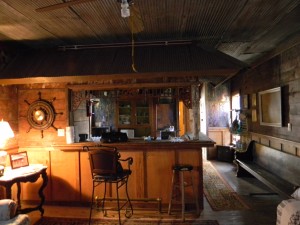 era or earlier, and this is obviously part of the intended experience. Bill would later tell me a little history about this shack.
era or earlier, and this is obviously part of the intended experience. Bill would later tell me a little history about this shack.
In another town in Mississippi, a sharecropper named Robert Clay lived his entire life in this humble abode, raising several sons by himself. When he was an old man, his sons, having moved out many years prior, tried to get him to leave this place and come live with them but he refused. He died an old man in the home in which he lived most of his life, and sometime after his death the shack was moved to it’s current location. After renovating the main body of the shack, the workers, upon exploring the attic to install duct work, discovered a whiskey still, making at least one reason apparent as to why Robert refused to leave. This kind of history just can’t be had at a Holiday Inn or Best Western and only added to the mystique.
One Amazing Sunset
After getting settled in and eating dinner we decided to walk around the grounds for a bit to take in some sites. While exploring the courtyard, the sun began to set on the distant horizon. We stood in wonderment as the sky transformed through a myriad of colors while the sun grew bigger and bigger before disappearing beneath the edge of the earth. In the last few moments before it became invisible beneath the horizon, the sky was on fire and time seemed to stand still. We took a few pictures to preserve the moment, and even though the photos are quite striking, it seems that some magical moments are intended for a single moment in time, coming and going like a breath of wind.
Blues Jam at Ground Zero
A little while later we headed out to the Ground Zero Blues Club, co-owned by Coahoma county resident Morgan Freeman, in downtown Clarksdale to attend the weekly Thursday night blues jam. This week it was being hosted by a local favorite, Big Anthony, and he was already on stage playing some fiery blues with his band when we walked in. Walking into a dark and unfamiliar night club with my guitar slung over my shoulder is something I’ve done many times before, but on this warm summer night in the deep South I must admit I was a little nervous, at least initially. The doorman was friendly enough, as was our waitress, and we gradually began to feel more comfortable after ordering a couple of beers and enjoying some of the show. Big Anthony, backed by a strong rhythm section of bass and drums, was playing some authentic Delta blues, his deep voice full of character, his guitar playing driving and relentless.
They took a break and then got up the first jammer, an older gentleman on vacation with his wife from Canada. After loaning this 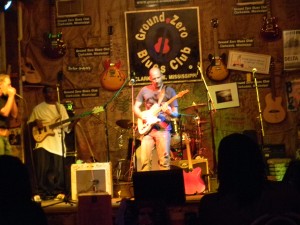 fellow his guitar for a couple of songs Anthony returned to the stage and called me up. Backed by the house drummer and bassist, I ripped through ‘Done Somebody Wrong’, ‘Goin’ Down’, and ‘Rock Me Baby’, and was quite pleased to receive a response that was somewhat over-the-top. Before leaving the stage, I announced that it was Kelly’s birthday and that we had come to Clarksdale to celebrate it, and several people applauded. As I exited the stage I got several compliments from other musicians who were waiting their turns in the wings. A few minutes later I walked over to the bar to get another beer and an older woman said to me “You were really good, but you don’t look like a blues musician.” “Blues musicians come in all shapes and sizes.” was the clarifying response I gave her before returning to my seat.
fellow his guitar for a couple of songs Anthony returned to the stage and called me up. Backed by the house drummer and bassist, I ripped through ‘Done Somebody Wrong’, ‘Goin’ Down’, and ‘Rock Me Baby’, and was quite pleased to receive a response that was somewhat over-the-top. Before leaving the stage, I announced that it was Kelly’s birthday and that we had come to Clarksdale to celebrate it, and several people applauded. As I exited the stage I got several compliments from other musicians who were waiting their turns in the wings. A few minutes later I walked over to the bar to get another beer and an older woman said to me “You were really good, but you don’t look like a blues musician.” “Blues musicians come in all shapes and sizes.” was the clarifying response I gave her before returning to my seat.
By this point we were starting to get kind of tired so we headed back to the shack. Our first day of this three-day trip drawing to a close, we sipped a beer on the back porch reminiscing our experiences. So far, this little town of Clarksdale had been a wonderful host, and we turned in for the night, excited for what Friday might bring.
The other day I was answering a questionaire for author, Wendy Willis’ upcoming book ‘Making It In Nashville‘ when one of the questions created a moment of pause – “What or who did you have to leave in order to chase your Nashville dreams?” The question was harder to answer than you might think and allowed for a great deal of reflection. As this factor is often underestimated if not ignored by those considering relocation to Nashville, I felt it was worthy of a post here.
The old saying “You never know what you have until it’s gone” is so true, and one that me and my family have come to fully understand upon relocating to Nashville. Shortly after I left my native homeland of New England I remember thinking “I’ll still be able to come home and visit once in a while. And of course I can always just call my friends and family on the phone when I miss them.” While initially this sounded like a good plan, the reality is that once you move 1300 miles away from your home, regular visits become impractical. And once those closest to you are no longer a part of your daily routines, some of these relationships can slowly begin to fragment.
Who did I have to leave to chase my Nashville dreams? When I left New England I left behind about 40 guitar students, many of whom I had been teaching for years and had become good friends. My parents and direct family, friends I had grown up with, people I played in bands with, and my wife and son’s family and friends were also rendered to essentially telephone and e-mail correspondence. You never realize how much you’ll miss these people until some time passes. Even though I do still keep in touch with my old friends and family, it’s still tough. In spite of the occasional visit back home, it’s almost as if many of them were part of another life.
What did I leave behind to chase my Nashville dreams? – Comfort, stability, my teaching career, my peers, my career as a nightclub musician, a familiar way of life, almost every relationship that ever meant anything to me, a 10 minute drive to the ocean, and all the familiar landmarks and places I had seen daily for 33 years. I also left behind harsh winters, as many bad habits as I could, and a music scene in which I could not find fulfillment. (In hindsight this lack of ‘fulfillment’ might actually have been more related to how I perceived myself than any fault of the music scene.)
The passage of time does change one’s perspective on life. It’s taken me almost a decade of working in Nashville to realize that I took a lot of things for granted in my earlier life. Nashville is a massive music industry full of opportunities that can’t be found elsewhere. While this is a good thing in some ways, it also creates an atmosphere of extreme competition, and a social atmosphere I often call ‘the land of the permanent job interview’. It wasn’t like that back home, and sometimes I miss that more carefree musical atmosphere. Most people in the Nashville music industry have an agenda and this can make it harder to find ‘real friends’. Sometimes I find myself yearning for the past, where genuine and deep relationships were more obvious.
While adjusting to the absence of all things familiar has been difficult, and I do miss my old life and friends, I am still glad I made this move. The journey has been far and wide, a life-changing experience that has taken me down many unsuspecting roads. Had I not embarked on this journey, I would not be the person I am today.
Anyone who has ever gigged in Nashville knows that it is hard to make any real money by playing in the clubs around town. Aside from a very small handful of gigs that might pay $75-$100 per player, most offer minimal to no pay – some offering a base pay $20 to $30 plus tips, a lot more offer tips only (which often means essentially playing for free), and a few are even pay to play. Even on the base pay plus tips gigs quite often a player will only take home $25 or $30.
So from time to time the “playing for free” debate rears up in conversations. Some say that performing music in public for free is the only way they can gain experience, obtain exposure, make connections, and have any sort of musical life beyond practicing in the basement. Others claim that playing for free makes it harder to receive fair (or any) compensation for their services. Why would clubs and venues pay for bands and players if most will do it for free?
While both are legitimate arguments, to understand why things are the way they are I think it is important to consider the overall role of music and musical performers throughout history, not just in today’s world.
Daniel Levitin, in his book “This Is Your Brain on Music” talks about music being at the heart of human evolution.
“No known human culture now or anytime in the recorded past lacked music. Some of the oldest physical artifacts found in human and protohuman excavation sites are musical instruments.”
He continues
Even more so in non-industrialized cultures than in modern Western societies, music is and was a part of the fabric of everyday life. Only relatively recently in our own culture, 500 years or so ago, did a distinction arise that cut society in two, forming separate classes of music performers and music listeners. Throughout most of the world and for most of human history, music making was as natural an activity as breathing and walking, and everyone participated. Concert halls, dedicated to the performance of music, arose only in the last several centuries.
With that, I state my case that music has always been there and is an important and crucial part of our being. It is perhaps the earliest form of communication. Somewhere along the way this art form, this way of life, morphed into a product, or a commodity.
In the book “Muse Power: How Recreational Musicmaking Heals Depression and Other Symptoms of Modern Culture” by Cheri D. Lunn writes:
Prior to the 20th century, the concept of selling music wasn’t really commonplace. One of the very first to consider music as a marketable commodity, was Wolfgang Amadeus Mozart. “In the mid-to-late 1700s, performers and composers such as Wolfgang Amadeus Mozart began to seek commercial opportunities to market their music and performances to the general public.” (5 Wikipedia /Dear Constanze The Guardian) Before that, in more traditional cultures, the Griots, bards, and musicians were cared for by their communities, as equals in the tribe doing their part to contribute. In Europe, up until the 1700’s music was supported by patronage from the aristocracy, or the church, and so there was no need for artists to sell themselves; and so the concept of selling music had just not yet come to be.
A crucial change in the history of folk music began during the twentieth century with folk artists adopting the very western concept of “marketing for money,” or “selling” the music of the people. In this time, a new genre of popular music arose that basically became an imitation to the original traditions of folk music as it was sung by ordinary people. These “folk” artists marketed themselves alongside more popular and modern emerging artists and created a niche for themselves by performing traditional music and songs in amplified concerts, and disseminating their work by recordings and broadcasting.
But along with the commercialization of music and musical performers, especially now in the digital age, comes somewhat of a desensitization to music, or what I call a ‘dumbing down’ of the masses in this regard. In today’s world, music is heard everywhere – from traditional advertising like TV and radio commercials to ring tones and ring backs, from video games to iPods, today’s Internet generation is saturated with digital music overload. In many situations, recorded music is now free, and with the advent of software like garage band, millions can now make homemade recordings to further flood the airwaves. In the midst of this oversaturation, TV shows like “American Idol”, “Nashville Star”, and “America’s Got Talent” have perpetuated the false reality that the masses can also now obtain superstardom.
Put all this together, and you’ve got more people than ever trying to get into the “music business”. But as millions more each year try to enter this world, the opportunities for them will inevitably shrink. There are only so many bars and nightclubs that need live music.
If you consider this history, it is fair to say that the concept of being paid for your music, or paid to play your music, is relatively new and largely an invention of our modern capitalistic society. Don’t get me wrong, I’m not suggesting we abandon this concept, this is how I am currently earning the bulk of my living. What I am suggesting is that the evolution of the paid musical performer may have been accidental, and is not necessarily a sustainable vocation in this modern world.
Music belongs to everybody. We need to better understand the role that music has played in our history, and how the cultivation of music as a part of our culture can benefit our world as well as the futures of our children. Does our future hold a world in which musical performers are paid for their ‘services’, or will the performance of music one day return to something that is shared by everybody? Did society really benefit when music was turned into a product? Do we deserve to be “paid to play”? I don’t know if I’ll always be able to earn a living from music, but even if one day I can’t, I’ll always play music, doing so enriches my life.
What is music, and the art of performing it worth to you?
Some people play music for the sheer joy of it, others do it for the money, and many fall somewhere in between. But regardless of music being a career or a hobby, the level of personal enjoyment and satisfaction achieved is largely up to the individual.
I started out as a young boy learning how to play music because it intrigued me. I had made some kind of spiritual connection early on (although I couldn’t have described it in that way at that time), and I felt compelled to play music. I was drawn in to this exciting new world and it was fun for me. Many years later, the thought entered my mind that “Hey, I love playing music, why not make a career out of it?” I gradually began to move in that direction, albeit without a clue as to where I was heading or how I would get there.
In the article ‘Making It’ in the Music Business – An Alternate View for the Independent Musician Graeme Kirk explores this topic in depth. He talks about being in his first band as a teenager and how they had fun in spite of not being very good. At some point into this band expedition he reached a crossroads.
“Like most young bands we reached a stage where reality reared its ugly head. “Get some good equipment”, we were told. “Practice every day…”, “…get a good manager…”, “…learn about the business…”, “..learn to write catchier songs…”
This seemingly good advice proved ultimately demoralizing and eventually his band broke up.
He goes on to write:
“So what?” you may ask. “You just didn’t have the commitment to make it in the music business”. True, but only because we didn’t realize that there can be many different definitions of “making it”. The problem is that most people who were giving us advice don’t realize it either. If we had only been told that there could be more to being in a band than the hard slog, paying your dues, waiting for record companies to notice your path that everyone assumes is the only way to succeed, things could have been much different.
It all comes down to how you define success – how you define “making it”.
The article goes on to talk about the fact that “there is no one path to success because there is no one definition of success.”, a simple, yet poignant thought that speaks volumes about the quandary that faces many musicians.
When you try to make a living as a musician, you base a lot of the decisions regarding your musical activity on financial factors. When paying the bills is directly tied to your gigs and musical activities, sometimes you’ll take gigs you might not otherwise take, basing these decisions on the financial outcome. Sometimes you might join a band or take on work that you don’t enjoy at all, simply because it pays well. On the other hand, some professional musicians are able to enjoy a majority of their musical endeavors, finding at least some shred of enjoyment even in the most difficult situations.
If your career lies elsewhere, your musical life can be of a purer nature. As you are not in it for the money, you are free to play music strictly based on your personal wants and desires, paying no mind to commercial appeal or financial gains. Sometimes the life of a musician who has not made music his career can be more rewarding than that of his professional musician counterpart. Of course this is not always the case either.
So the bottom line is, you have to decide what you want to get out of music, what you want to get out of life, and if having a career in music is needed to accomplish these goals. Maybe you do, but then again maybe you don’t. If you’re thinking about diving in, arming yourself with as much pertinent knowledge as possible is always a good idea. If you’re already well on the path of a career minded musician, keep forging ahead. But whatever you do, always strive to make your musical activites as stress free and fun as possible. Because if you’re not enjoying it, what’s the difference between playing a gig and punching a time clock at a factory job you don’t like.
Enjoying any activity is as much about your perception of that activity as it is anything else. Fun is an attitude, not necessarily a condition, so do your best to maintain a positive outlook and you should be rewarded accordingly. Whether music is your career, your hobby, or something you do for a occasional enjoyment, music is the backdrop of life, and life can be hard. So do your best to make your music count. If you want to have fun with music, make it a conscious decision to do so, because having fun with music is all in your head.
“Decide, commit, succeed!” – Tony Horton
